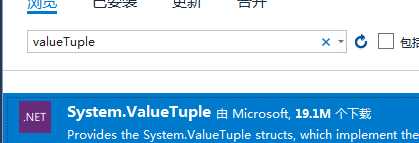标签:使用 关于 .net model void val bubuko 构造函数 忽略
自从c#7.0发布之后,其中一个新特性是关于tuple的更新,使得tuple在编码中更受欢迎
先总结一下tuple的常规用法
Tuple的美式发音为 /?tj?p?l; ?t?p?l (方便在讨论的时候准确发音,我是闹过笑话)
Tuple是C# 4.0时出的一个新特性,因此.Net Framework 4.0以上版本可用。
有两种方式可以创建tuple元祖对象,如下所示
//1.使用tuple的静态方法创建tuple
{
//最多支持9个元素
var tuple = Tuple.Create<int, int, int, int>(1,2,3,4);
}
//2.使用构造函数构造tuple
{
var tuple = new Tuple<int>(1);
}
static void Main(string[] args)
{
//1.使用tuple存入相关信息,替代model对象,标识一组信息
{
var tuple = new Tuple<int, string, string>(1, "张山", "1班");
}
//2.作为方法的返回值
{
var tuple = GetTuple();
}
}
static Tuple<int, int> GetTuple()
{
Tuple<int, int> tuple = new Tuple<int, int>(1, 2);
return tuple;
}
3、tuple取值
static void Main(string[] args)
{
//1.使用tuple存入相关信息,替代model对象,标识一组信息
{
var tuple = new Tuple<int, string, string>(1, "张山", "1班");
int id = tuple.Item1;
string name = tuple.Item2;
}
//2.作为方法的返回值
{
var tuple = GetTuple();
var id = tuple.Item1;
}
}
static Tuple<int, int> GetTuple()
{
Tuple<int, int> tuple = new Tuple<int, int>(1, 2);
return tuple;
}
以上就是tuple使用三部曲
下面在看下c#7.0关于tuple的新特性

static void Main(string[] args)
{
//1.新特性使用
{
var valueTuple = GetValueTuple();
int id = valueTuple.id;
string name = valueTuple.name;
string className = valueTuple.className;
//可以对返回参数进行解构,解析成更明确的表达
var (id1,name1,className1)= GetValueTuple();
int id2 = id1;
//忽略自己不必使用的值
var (id3, _, _) = GetValueTuple();
}
//2.常规tuple使用
{
var tuple = GetTuple();
int id = tuple.Item1;
string name = tuple.Item2;
string className = tuple.Item3;
}
}
static (int id, string name, string className) GetValueTuple()
{
return (1, "张三", "一班");
}
static Tuple<int, string, string> GetTuple()
{
Tuple<int, string, string> tuple = new Tuple<int, string, string>(1, "张三", "一班");
return tuple;
}
1、ValueTuple的返回值写法更简洁,且方法返回声明更明确,
因此方法调用方能够明确获取方法返回值定义的参数名
2、ValueTuple可对返回参数进行解构
升级到了 .NET Framework 4.6.2就可以使用c# 7.0的语法了,也就可以使用ValueTuple
标签:使用 关于 .net model void val bubuko 构造函数 忽略
原文地址:https://www.cnblogs.com/xxue/p/9926182.html